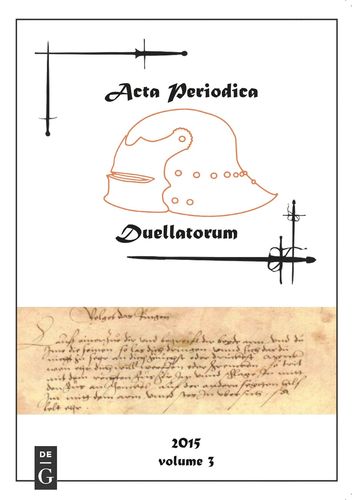A comparative analysis of literary depictions of social violence in two important 16th Century autobiographies, from the perspective of the fencing manuals of the Renaissance
DOI:
https://doi.org/10.36950/apd-2015-004Keywords:
dueling, social conflict, Cellini, Sastrow, Rome, Renaissance, Florence, Greifswald, Reformation, fencing, swords, Joachim Meyer, Bolognese School of Fencing, Achille Marozzo, George Silver, Nicoletto GigantiAbstract
In the late 16th century two interesting individuals made substantial contributions to the relatively new genre of the autobiography. In 1595 Bartholomäus Sastrow (1520–1603), a north German burgher, notary, diplomat, and eventually burgomeister of the Hanseatic City of Stralsund, penned his life story. Benvenuto Cellini (1500–1571), goldsmith, soldier, musician and famous Renaissance artist from Florence, wrote his memoir between 1558 and 1563. Though they were born twenty years apart, both men had similar backgrounds. Both were from the lower-middle strata of society but rose to high status, both were widely traveled and directly acquainted with the most powerful individuals of their time (as well as some of the most lowly) and both experienced firsthand some of the most dramatic and important political and military events of the mid-16th century. Amidst a backdrop of war and severe religious conflict, Sastrow, a German and a Lutheran, traveled to Italy, and Cellini, an Italian Catholic, travelled through Germany to France. This allows us to see each region from both a native and an outsider’s perspective. Both men participated in or were witness to numerous incidents of social violence and warfare during their lifetimes, as described in detail in their memoirs. These accounts give us an opportunity to examine the depiction of incidents of social violence by people who witnessed or participated in them first-hand, allowing us to contrast these episodes with the principles of self-defense as portrayed in the fightbooks. We can also compare these personal anecdotes with documented written and unwritten rules governing dueling, fighting, and the carrying of arms. This will help grant us further insight into the reality of personal armed conflict in the era of the fightbooks, and improve our understanding of their context and meaning.Downloads
Download data is not yet available.
Downloads
Published
2015-09-19
Issue
Section
Articles
License
Copyright (c) 2015 Jean Chandler

This work is licensed under a Creative Commons Attribution-NonCommercial-NoDerivatives 4.0 International License.
How to Cite
Chandler, J. (2015). A comparative analysis of literary depictions of social violence in two important 16th Century autobiographies, from the perspective of the fencing manuals of the Renaissance. Acta Periodica Duellatorum, 3(1), 67–79. https://doi.org/10.36950/apd-2015-004



